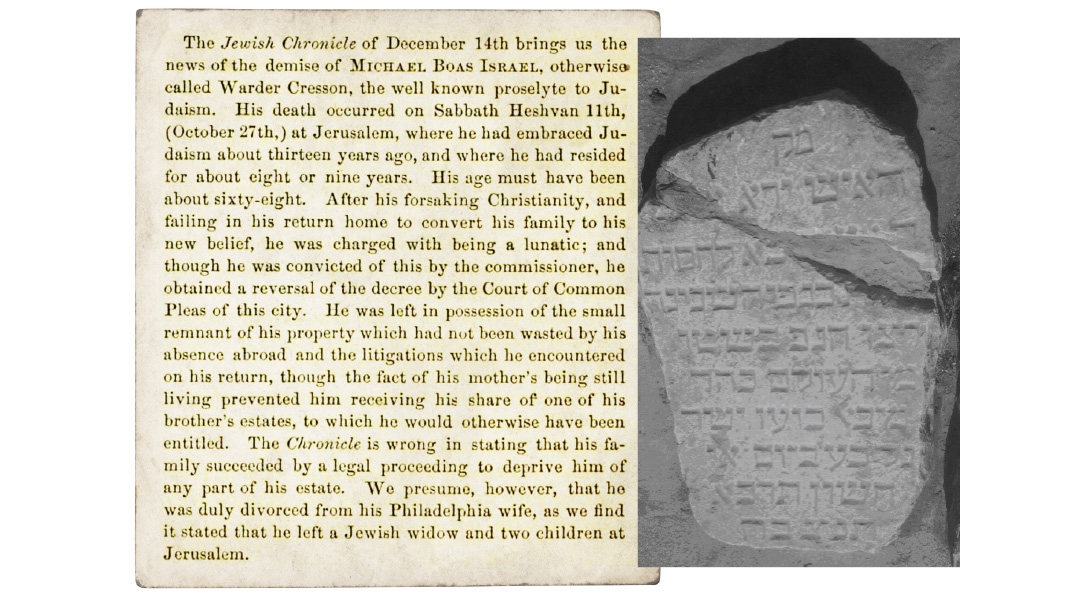A Quaker’s Quest for Clarity
| February 7, 2023Finally, at the age of 49, this restless soul had found its calling

Title: A Quaker’s Quest for Clarity
Location: Philadelphia, Pennsylvania
Document: The Occident and American Jewish Advocate
Time: January 1861
IN 1840, Warder Cresson, a wealthy Philadelphia area farmer and devout Quaker, became acquainted with Isaac Leeser, the minister of the Spanish-Portuguese congregation Mikveh Israel. He began to attend his lectures, and discovered a religion to satisfy his lifelong spiritual quest. He was also influenced by the messianic ideas of Mordecai Manuel Noah, who advocated a movement for the return of the Jewish People to its ancient homeland.
In 1844, Cresson persuaded Secretary of State John C. Calhoun to appoint him America’s first-ever consul to Jerusalem. Shortly thereafter he was on his way to the Middle East.
He later wrote of his departure for Jerusalem as follows: “In the spring of 1844, I left everything near and dear to me on earth. I left the wife of my youth and six lovely children (dearer to me than my natural life), and an excellent farm with everything comfortable around me. I left all these in the pursuit of the Truth, and for the sake of the Truth alone.”
Shortly following his arrival in Jerusalem, he discovered that his appointment had been rescinded. Nevertheless, Cresson chose to ignore the order and continued to act as consul. He began to fight against the efforts of local missionaries and proudly noted that “they failed to apostatize even one Jew.” He was greatly affected by the surroundings of the Holy City, and as he developed relationships with the local Jewish community it was clear that finally, at the age of 49, this restless soul had found its calling:
I remained in Jerusalem in my former faith until the 28th day of March, 1848, when I became fully satisfied that I never could obtain Strength and Rest but by doing as Ruth did, and saying to her Mother-in-law, or Naomi, “Entreat me not to leave thee; for whither thou goest, I will go; and where thou lodgest, I will lodge; thy people shall be my people and thy G-d my G-d.” Upon the 28th day of March, 1848, I was circumcised, entered the Holy Covenant and became a Jew.
Adopting the name Michoel Boaz Yisrael, he joined the Sephardic community and became a close acquaintance of Chacham Yechiel Cohen and Chacham Yaakov Shaul Elyashar. In 1848, he returned to Philadelphia to settle his affairs so he could return to the Holy Land for good.
When his family learned of his determination, they interposed every possible obstacle to the execution of his plans. In May 1849, his wife and son applied to the court and had him declared insane and legally incompetent. He appealed, and the trial, extending over six days in May 1851, was one of the famous cases of the time. Eminent counsel was retained by both sides, and nearly 100 witnesses testified.
One of the baseless accusations hurled by opposing counsel was that Cresson, upon returning to Jerusalem, would “give all his money to rebuild the Temple.” Cresson calmly responded, “How could I have made such a vow while Mount Moriah is still occupied by a mosque?” He was vindicated of all charges, and the verdict was celebrated by the press as a victory for religious freedom.
Returning to Jerusalem following the trial, he pioneered initiatives for Jewish agricultural colonization in Palestine. He married a Sephardic woman named Rachel Moleano and had two children, both of whom perished during their childhood. He lived out his days as a pious Jew, dressed as a native Sephardi, and became a prominent leader of the community.
Upon his passing in 1860, a large crowd escorted him to his resting place on Har Hazeisim. In 2013, his matzeivah was rediscovered. It aptly reads: “A man who fears G-d, Who came to shelter him under the wings of the Shechinah.”
Morocco or America?
In the spring of 1848, a senior sage of Yerushalayim named Rav Asher Lemel Levy addressed a halachic query to Rav Yaakov Ettlinger, author of Aruch Laner. One “non-Jew who had arrived from Morocco for the purpose of conversion, and had undergone a bris milah.” Since he hadn’t yet immersed in the mikveh, his gentile status still applied, and therefore Rav Asher Lemel instructed him to deliberately desecrate Shabbos.
The ensuing uproar from other Jerusalem rabbis had him turn to the Aruch Laner for advice. The Aruch Laner concurred with the other rabbis and concluded that the bris sufficed for the requirement to observe Shabbos. But who was the mysterious convert?
It has been posited by Rabbi Yirmiya Milevsky that since the date of the conversion referred to in the query of Rav Asher Lemel coincides with the exact date stated by Warder Cresson in his memoir as the date of his circumcision, perhaps it was none other than the Quaker convert from Philadelphia. When spelled out in rabbinic Hebrew, the spellings of Morocco and America are nearly identical. This would also resolve the question as to why someone from Morocco — which had its own rabbinical courts — would travel to Jerusalem for his conversion.
Early American Intervention
An 1854 episode recounted by Cresson marked the first-ever occurrence of US military intervention in the Land of Israel. Reports of Bedouin marauders terrorizing American citizens residing near Jaffa led to the arrival of the SS Levant, commanded by Captain C.C. Turner, on June 3. The offending Arabs were located, hauled before an Ottoman court, and imprisoned.
Yale Gibber’s highly recommended book The Long Hard Road was utilized in the preparation of this column.
The kever of Michoel Boaz Israel (Warder Cresson) is just one of the many fascinating stops on Yehuda Geberer’s Har Hazeisim tours. For more information, see YehudaGeberer.com.
(Originally featured in Mishpacha, Issue 948)
Oops! We could not locate your form.






